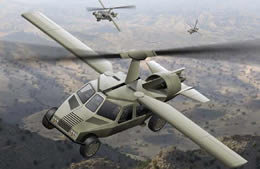
To meet much of transportation needs of today’s deployed Warfighter, either highly mobile multipurpose wheeled vehicles (HMMWV) are used, or helicopters, which have limited availability, are used. DARPA’s Transformer (TX) program seeks to combine the advantages of ground vehicles and helicopters into a single vehicle equipped with flexibility of movement. Such vehicle could avoid potential asymmetrical threats such as IEDs and ambushes as well as overcome road obstacles. In October 2010 DARPA has announced AAI Corporation and Lockheed Martin Company were selected as prime system integrators for the teams of vendors participating in the 12-month study.


Transformer type vehicles will implement new technologies to be demonstrated and matured through the different phases of the program. Power generation, propulsion systems, vertical lift will transformable airfoils are expected to be major challenges, enabling relatively heavy TX vehicles to maintain reasonable power/weight ratio necessary for vertical takeoff and flight. Carnegie Mellon University, Pratt & Whitney Rocketdyne were selected to develop some of these critical technologies. Aurora Flight Sciences partnered with electrical motor specialist ThinGap were also selected to demonstrate relevant technologies, along with multi-disciplinary expert Metis Design Corp. The vehicle will require advanced guidance and flight control systems, allowing semi-autonomous flight, permitting a nonpilot to perform VTOLs, transition into forward flight, and update the flight path in response to changing mission requirements or threats.
During the program’s first phase, performers will conduct trade studies to develop and mature propulsion systems, adaptable wing structures, advanced lightweight materials, the advanced flight control system, the air/ground configuration designs, and energy distribution systems. The developers of critical enabling technologies will work with the prime system integrators, incorporating their technology for a possible second phase. These trade studies will allow for development of a detailed technology maturation plan to ensure a feasible design of the vehicle and its supporting technology. Results of this initial phase will be used by DARPA to inform future phases.

The TX program aims to develop a robust ground vehicle that can transform into an air vehicle with vertical take-off and landing (VTOL) capability, efficiently travel 250 nautical miles on land and in the air, while carrying up to 1,000 pounds of payload. (This payload requirement represents up to four Warfighters and their equipment or equivalent weight in logistical supply or critical medical evacuation). With this type technology, transportation will no longer be restricted to trafficable terrain that tends to make movement predictable. According to DARPA, benefits of enhanced mobility will be numerous, including improved resupply capabilities, flexible insertion and extraction of fire-team, and more efficient medical evacuation, increasing the probability of casualty survival.



















